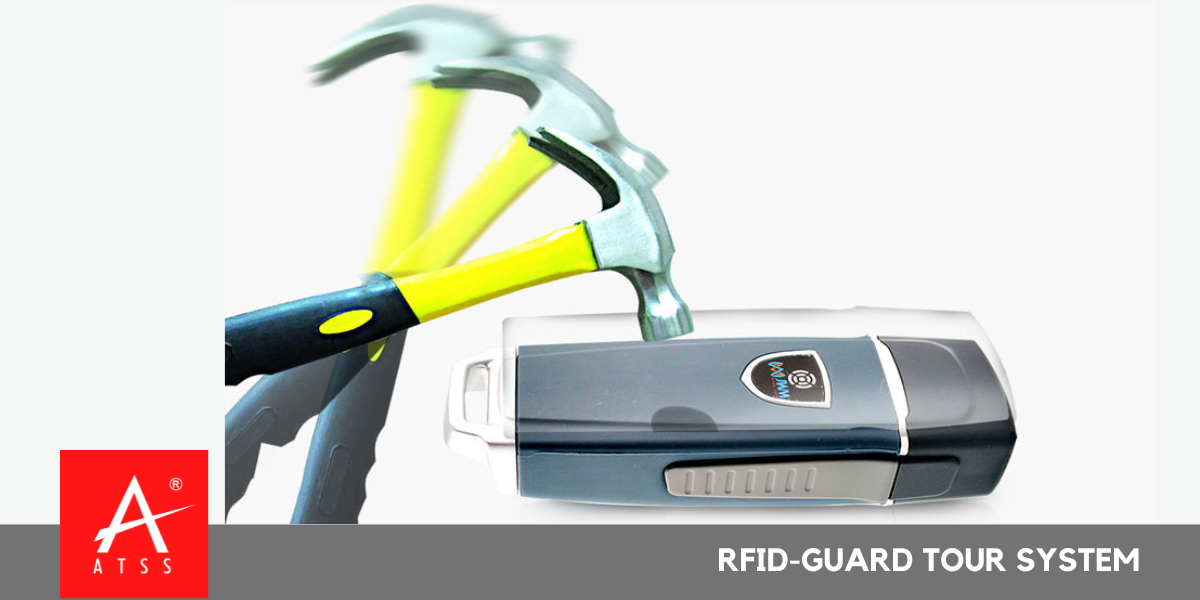
RFID Guard Tour System
Security Guard Patrol System – ATSS
RFID Guard Tour System is an advanced, cost-effective, and reliable solution for managing a guard patrol system. RFID Guard Tour System records the entry and exit of each security guard at the premises and also captures the duration of stay.
A guard tour patrol system is a system for logging the rounds of employees in a variety of situations such as security guards patrolling property, technicians monitoring climate-controlled environments, and correctional officers checking prisoner living areas.
It helps ensure that the employee makes his or her appointed rounds at the correct intervals and can offer a record for legal or insurance reasons. Such systems have existed for many years using mechanical watch clock-based systems (watchman clocks/guard tour clocks/patrol clocks).
Computerized systems were first introduced in Europe in the early 1980s, and in North America in 1986. Modern systems are based on handheld data loggers and RFID sensors. The system provides a means to record the time when the employee reaches certain points on their tour.
Checkpoints or watch stations are commonly placed at the extreme ends of the tour route and at critical points such as vaults, specimen refrigerators, vital equipment, and access points. Some systems are set so that the interval between stations is timed so if the employee fails to reach each point within a set time, other staff is dispatched to ensure the employee’s well-being.
An example of a modern set-up might work as follows: The employee carries a portable electronic sensor (PES) or electronic data collector which is activated at each checkpoint. Checkpoints can consist of iButton semiconductors, magnetic strips, proximity microchips such as RFIDs or NFC- or optical barcodes.
The data collector stores the serial number of the checkpoint with the date and time. Later, the information is downloaded from the collector into a computer where the checkpoint’s serial number will have an assigned location (i.e. North Perimeter Fence, Cell Number 1, etc.).
Data collectors can also be programmed to ignore duplicate checkpoint activations that occur sequentially or within a certain time period.
Computer software used to compile the data from the collector can print out summaries that pinpoint missed checkpoints or patrols without the operator having to review all the data collected. Because devices can be subject to misuse, some have a built-in microwave, g-force, and voltage detection.
System composition: It combines readers, tags, and software.
Guard Patrol Reader
The first Guard tour system is the touch readers with software. As the development, there is more working mode for readers. Such as RFID and GPS. And the communication of readers and software was connected with USB cables or download stations. For USB connection, the Pogo Pin connection is very popular. Because the contacts with gold plating are very stable and waterproof.
Newer, lightweight guard touring systems utilize QR codes or barcodes rather than expensive electronic components. A mobile phone app is used to scan (take a photo) of the QR code which creates a time stamp in the system.
Guard Patrol Tags
The reader needs to read the tags to record the information, such as the time and tag ID. Then upload the information to the software to get the report.
Guard ID tags:
There are touch ibuttons or RFID tags. The guard ID tags replace the name of the guard.
Checkpoint tags:
There are touch ibuttons or RFID tags. The checkpoint tags replace the checkpoints which guards need to patrol.
Event wallets:
There are many event tags in it. And they are touch ibuttons or RFID tags. Each tag means one event thing. When the reader reads the tag, it will get the event. For example, fire, stolen, or broken.
QR Codes:
QR codes or barcodes can be used instead of more expensive electronic readers. The codes are often printed on stickers that can be easily placed nearly anywhere, changed (to ensure accountability), or added to change touring routes.
Guard Patrol Software
There are three versions of guard patrol software. They are the desk version, CS version, and web-based version. The desk version can only work on one computer. The CS version can work under the local area network.
The web-based version can work everywhere with internet access. In the analog age, the device used for this purpose was the watch clock. Watch clocks often had a paper or light cardboard disk placed inside for each 24-hour period. The user would carry the clock to each checkpoint, where a numbered key could be found (typically chained in place).
The key would be inserted into the clock where it would imprint the disk. At the end of the shift or 24-hour period an authorized person (usually a supervisor) would unlock the watch clock and retrieve the disk. With the development of the guard tour system, the device can work with more functions.
Such as sending data in real-time by GPRS to software and GPS location and tracking mode. In software, we set up the Patrol Department, Patrol Route, Guard, Checkpoint, Event, and Patrol Plan in general, depending on the software purchased.
The software will then have specific tours set for officers to complete, being able to indicate whether the inspection was completed properly or not, with the ability to note a specific temperature of an inspection or make any kind of notes necessary. Guard Tour software systems seem to be becoming the norm in tracking tours for officers.
New touring solutions rely on cloud-based Software as a Service (SaaS) and QR codes to accomplish many of the tasks of traditional touring systems, but at lower deployment cost and higher ability to modify the system quickly. This is important when routes change, or if a solution is needed on short notice.
QR code-based touring systems typically utilize a mobile phone app to scan (photograph) the QR code and then upload that information along with a time stamp, phone’s location information, and optionally other information the guard enters into the app on the phone.
This setup removes the complexity of running touring software on a location computer, syncing via USB or other mechanisms, purchasing additional hardware, and provides instant access to tour information as it is uploaded by the app, rather than when a guard returns to the station.
RFID Guard Tour System
Used for Security Guard Patrol, Equipment Maintenance, Fleet Control, Lawn Service Routes, Delivery Routes, Sales Personnel Routes, Alarm Responsive Routes, Fire Extinguisher Routes, Cleaning Service Routes Maintenance Routes, etc.
Article From Wikipedia

